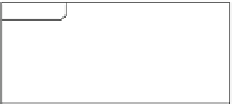Database Reference
In-Depth Information
DA
GSCL
I
MS
UAA
P-CSCF
S-CSCF
MTAS/AP
HSS
I
MS UA
(phone
)
HTTP
1:UPDATE (PUT)
door bell ring
2:
STATUS-OK (204)
3:NOTIFY (POST)
door bell ring
4
: STATUS-OK (204)
SIP
5: INVITE
6: INVITE
7: INVITE
8: INVITE
9: LIR (DIAMETER)
10: LIA (DIAMETER)
11: INVITE
12: INVITE
13: INVITE
14: INVITE
15: 200 OK
16: 200 OK
17: 200 OK
18: 200 OK
19: 200 OK
20: 200 OK
21: 200 OK
22: 200 OK
Multimedia Session Establishment
Fig. 8.
Multimedia session establishment
2
GSCL accepts update and respond with STATUS-OK.
3
GSCL notifies IMS User Agent Application (UAA), which is subscribed
to door bell status data, that door bell is ringing.
4
UAA accepts data.
5-6
The UAA on gateway initiates a SIP-INIVITE request with SDP Offer
[
4
,
6
] towards S-CSCF (A) via P-CSCF keeping UE-B IP Address in
Request URI to establish the session.
7-8
Based on initial filter criteria (IFC) configured in S-CSCF (A) for the
originating services of UE-A, the S-CSCF (A) sends the INVITE request
towards the application server (MTAS) to invoke telephony services.
MTAS initiates a new INVITE request with a CALL-ID towards
S-CSCF (A).
9-10
Based on the UE-B IP in Request URI within INVITE message, S-CSCF
sends the Location Information Request towards HSS requesting the S-
CSCF details for UE-B. HSS acknowledges the request by providing the
IP address of the S-CSCF serving UE-B.
11-12
Based on IFC's configured in S-CSCF (B) for the terminating services
of UE-B, the S-CSCF (B) sends the INVITE request towards MTAS to
invoke telephony services. MTAS initiates a new INVITE request with
a CALL-ID towards S-CSCF (B).
13-14
S-CSCF sends the INVITE request towards UE-B via P-SCSF to estab-
lish the session.
15-16
UE-B acknowledges the request by sending 200 OK towards S-CSCF (B)
via P-CSCF including the SDP Answer.


























































Search WWH ::

Custom Search